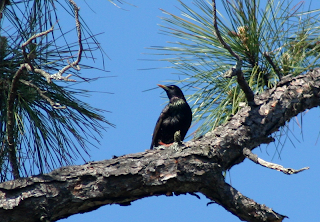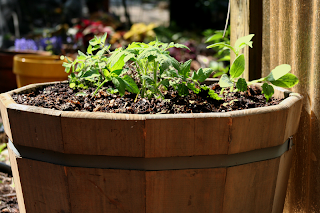More and more people are becoming interested in growing moss gardens. I've been asked how I grew mine, so I will share.
I started my moss garden just last winter when I came to terms with the fact that there was one spot in my garden where no plants were ever happy. It's an area that drains poorly, and has rich silty soil that is packed down. Water pools in the area when it rains a lot. It's on the north side of my house and is shaded by a small live oak tree.
I prepared the area by adding some soil acidifier for good measure, and packing the soil back down. I collected the first pieces of moss from my parents' property, which has a large area of beautiful ferny looking moss. Their soil has lots of clay, whereas ours beneath the amended topsoil is pure sand. I collected large pieces in zip-lock bags, brought them home, and planted them immediately.
The picture above shows the fairly-new planted mosses, still looking a bit choppy. Below is a recent picture showing it having anchored itself down and filling in nicely. Note that the moss on the pots has receded somewhat. It's not that easy getting moss to survive on pots, but the surviving moss has attached itself to its surface.
The rule-of-thumb is that you should plant moss on a similar surface to where you find it growing naturally. So, moss found growing on wood, I planted on wood. Moss growing in dirt, I planted in dirt. I even found moss growing in sunny areas on sand, which I planted on the side of my little plot that gets afternoon sun.
Where did I find my mosses? Everywhere! I started taking walks around the neighborhood and found the most amazing mosses. I found mosses growing along drainage ditches, on the side of the road, I went into some woods and found some hiding under pine needles, and I found them growing on the banks of my own little creek. I strolled onto a piece of property that had been abandoned since our big hurricane, and found the most beautiful mosses--some a lush velvety green and some with star shapes that grew a few inches tall. I found mosses whose spores made them look so beautiful and delicate. Eventually, I ran out of room for them.
While the dominant moss is the ferny-looking moss, if you look closely, you can see the other types in between. I planted the pieces together like a living patchwork quilt.
On my daily walks, I carried a small spoon and a plastic bag. I don't know what people thought I was doing. Most people who walk with plastic bags pick up dog poop, but I don't have a dog. They'd see me bent over in abandoned lots, and straddling drainage ditches digging, things up and putting them into a plastic bag.
I kept my moss garden moist by making sure it was watered every day. We have a well for irrigation, so there was no worry of killing it with nasty chemical-laced city water. When the oak tree dropped its leaves, and the sun was beating down on my poor little mosses, I cut strips of window screening and laid them over the area. This allowed diffused light and water in, and also seemed to hold the moisture in a bit. I knew that once my tree filled in again, and the sun moved farther north that I could uncover them again. (See
Moss Under Wraps)


























































